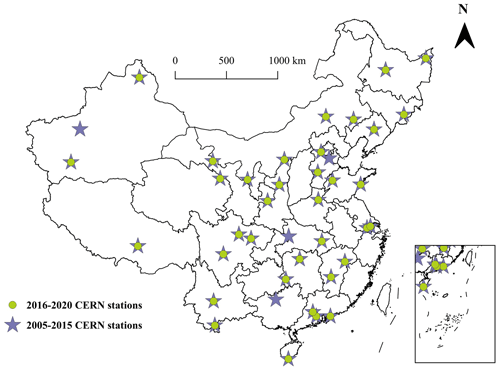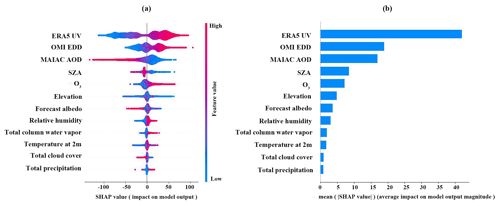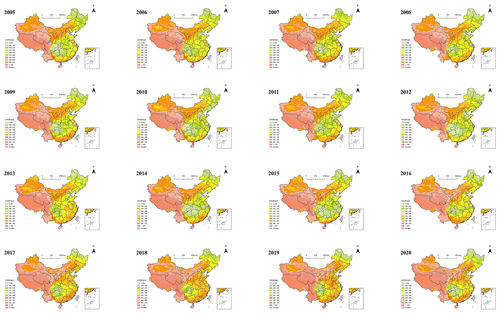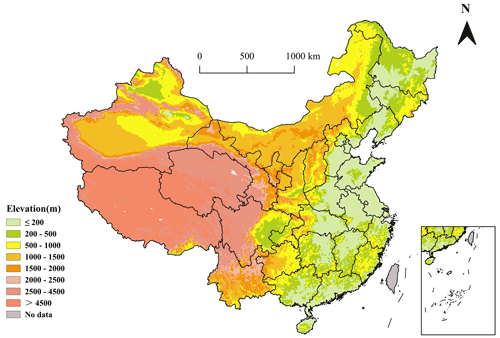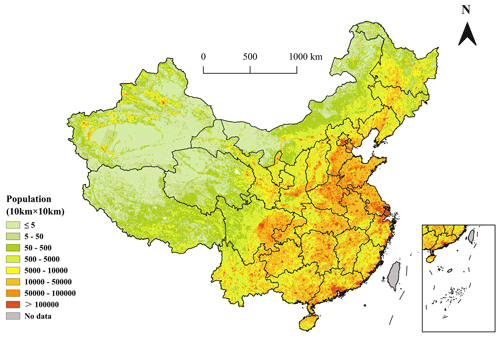the Creative Commons Attribution 4.0 License.
the Creative Commons Attribution 4.0 License.
A 10 km daily-level ultraviolet-radiation-predicting dataset based on machine learning models in China from 2005 to 2020
Yichen Jiang
Su Shi
Xinyue Li
Chang Xu
Haidong Kan
Ultraviolet (UV) radiation is closely related to health; however, limited measurements have hindered further investigation of its health effects in China. Machine learning algorithms have been widely used to predict environmental factors with high accuracy, but a limited number of studies have implemented it for UV radiation. The main aim of this study is to develop a UV radiation prediction model using the random forest approach and predict the UV radiation with a daily and 10 km resolution in mainland China from 2005 to 2020. The model was developed with multiple predictors, such as UV radiation data from satellites as independent variables and ground UV radiation measurements from monitoring stations as the dependent variable. Missing satellite-based UV radiation data were obtained using the 3 d moving average method. The model performance was evaluated using multiple cross-validation (CV) methods. The overall R2 and root mean square error between measured and predicted UV radiation from model development and model 10-fold CV were 0.97 and 15.64 W m−2 and 0.83 and 37.44 W m−2 at the daily level, respectively. The model that incorporated erythemal daily dose (EDD) retrieved from the Ozone Monitoring Instrument (OMI) had a higher prediction accuracy than that without it. Based on predictions of UV radiation at the daily level, 10 km spatial resolution, and nearly 100 % spatiotemporal coverage, we found that UV radiation increased by 4.20 %, PM2.5 levels decreased by 48.51 %, and O3 levels increased by 22.70 % from 2013–2020, suggesting a potential correlation among these environmental factors. The uneven spatial distribution of UV radiation was associated with factors such as latitude, elevation, meteorological factors, and season. The eastern areas of China pose a higher risk due to both high population density and high UV radiation intensity. Using a machine learning algorithm, this study generated a gridded UV radiation dataset with extensive spatiotemporal coverage, which can be utilized for future health-related research. This dataset is freely available at https://doi.org/10.5281/zenodo.10884591 (Jiang et al., 2024).
- Article
(13667 KB) - Full-text XML
- BibTeX
- EndNote
Ultraviolet (UV) radiation is a crucial environmental factor closely associated with human health (Brenner and Hearing, 2008; Narayanan et al., 2010). Previous studies have confirmed the hazardous effects of UV radiation on skin cancer (Griffin et al., 2023; Vienneau et al., 2017), but inconsistent results have been reported regarding the direction of UV radiation's impact on eye diseases (Lagreze et al., 2017; Tian et al., 2018; Wolffsohn et al., 2022) and whether moderate UV radiation is beneficial to health (Boscoe and Schymura, 2006; VoPham et al., 2017; Swaminathan et al., 2019). Further studies are required to ascertain the effects of UV radiation on human health; however, the lack of highly accurate exposure data of UV radiation hinders such health-related investigations.
Exposure assessment methods used in previous health studies on UV radiation mainly include the following: first, the UV index, a frequently used proxy for UV radiation in epidemiological studies (Thayer, 2014; Marson et al., 2021; Walls et al., 2013). It predicts UV radiation levels on a scale from 1 to 11+. Although the UV index is easy to interpret, converting continuous measurements of UV radiation to the UV index results in the loss of numerical information. The second method is satellite remote sensing data, often used to estimate UV radiation exposure. For example, erythemal UV irradiance from the Total Ozone Mapping Spectrometer (TOMS), despite being one of the initial instruments for evaluating the UV radiation backscattered by the Earth's atmospheric layers, exhibits a lower spatial resolution of 50 km×50 km and has limited accuracy (Boscoe and Schymura, 2006; Mohr et al., 2008; Lin et al., 2012; Zhou et al., 2019). Erythemal daily dose (EDD) retrieved from the Ozone Monitoring Instrument (OMI) can be utilized to evaluate the UV radiation exposure level with a higher spatiotemporal resolution and was employed in the United States to represent ground UV radiation levels and identify hotspots for skin cancer (Zhou et al., 2019; Deng et al., 2021). However, missing values of the OMI EDD data were non-random. Since 2008 in particular, the field of view of the instrument has been partially obstructed by the peeling of the spacecraft's protective film, leading to data loss in the center-right section of each observational swath. This has greatly increased the missing rate of OMI EDD data, posing a challenge to the accuracy of exposure assessments in epidemiological studies (McPeters et al., 2015). The third method is personal dosimeters, often worn to measure individual exposure (Stump et al., 2023; Grandahl et al., 2018). Although the data quality from this method is high, the costs are substantial, making it difficult to apply in large-population studies. Therefore, UV radiation data of higher accuracy and spatiotemporal resolution are required to support further exposure assessments.
The enrichment of data resources and improvements in computing power have led to the development of machine learning algorithms. Machine learning algorithms can integrate data from multiple sources to predict environmental factors with high quality (Chen et al., 2021; Zhu et al., 2022; Liu et al., 2022). However, empirical or statistical models are generally used for UV radiation prediction (González-Rodríguez et al., 2022; VoPham et al., 2016; Pei and He, 2019; Liu et al., 2017). In recent years, some pioneering studies have employed machine learning algorithms to predict UV radiation in China (Wu et al., 2022; Qin et al., 2020). The spatiotemporal resolution of the predictions of one study was relatively low (0.50°×0.625°) (Qin et al., 2020), while the other produced UV radiation predictions with a significant amount of missing data of one predictor (aerosol optical depth from satellite), which may lead to seasonal bias in the UV radiation assessment (Wu et al., 2022). In addition, these studies did not include direct measurements of UV radiation from satellites, such as the OMI EDD, which has been proven to be an effective predictor of UV radiation evaluation (Zhou et al., 2019; Deng et al., 2021). Satellite-based measurements can be used as one of the “real” measurements of UV radiation, which can help constrain the overfitting of the model in spatiotemporal extrapolation. Overall, further studies are required to add more evidence to the model development of UV radiation using advanced algorithms and comprehensive predictors.
Therefore, this study aimed to develop a random forest model, one of the machine learning algorithms, to predict UV radiation in mainland China at the daily level and a spatial resolution of 10 km in 2005–2020. Multiple predictors, including satellite-based UV radiation, UV radiation simulations, and parameters from reanalysis meteorological datasets were included in the model development. The missing satellite-based UV radiation data fields were filled to improve the spatial coverage of the final UV radiation predictions. Finally, based on predictions with relatively high spatiotemporal resolution and a long time period, temporal and spatial trends as well as hotspots of UV radiation were identified in mainland China.
2.1 Data
2.1.1 Ground UV radiation measurements
The Chinese Ecosystem Research Network (CERN) has been observing UV radiation since 2004 (Liu et al., 2017). The monitoring data are available online at http://www.cern.ac.cn/ (last access: 10 February 2023). Hourly monitoring data on UV radiation from 40 ground-based stations between 2005 and 2015 and 36 ground-based stations between 2016 and 2020 were collected from CERN (Fig. 1). These stations cover eight ecological land-cover types across China: urban, agricultural, grassland, forest, lakes, bays, wetlands, and deserts. Daily UV radiation values were calculated by adding the 24 h UV radiation values per day. Days with continuous 2 h missing or unavailable UV radiation values were excluded.
2.1.2 Predictors directly related to UV radiation
In this study, level-2 OMI EDD (v.003) data, which have a temporal resolution of the daily level and a spatial resolution of 0.25°×0.25°, were utilized as the main predictor of UV radiation (Zhou et al., 2019). The OMI EDD represents the overall amount of UV radiation that can cause sunburns during the day. The other predictor was the downward UV radiation at the surface from the fifth-generation European Center for Medium-Range Weather Forecasts Reanalysis at single levels (ERA5 UV), with an hourly temporal resolution and a spatial resolution of 0.25°×0.25° (https://cds.climate.copernicus.eu/, last access: 11 September 2023). Daily ERA5 UV data were obtained by adding data over 24 h for each day. OMI EDD and ERA5 UV data with a spatial resolution of 0.25°×0.25° were interpolated to 10 km grid cells using the inverse distance weighting (IDW) method.
2.1.3 Meteorological parameters
Meteorological parameters that may affect UV radiation were extracted from multiple ERA5 products (https://cds.climate.copernicus.eu/) according to previous studies (Dieste-Velasco et al., 2023; Hu et al., 2010). The total cloud cover, total column water vapor, and forecast albedo were extracted from a single-level ERA5 product with an hourly temporal resolution and a spatial resolution of 0.25°×0.25°, and the relative humidity was extracted from the pressure-level ERA5 product at 1000 hPa with an hourly temporal resolution and a spatial resolution of 0.25°×0.25°. The total precipitation and temperature at 2 m were extracted from the ERA5-Land product with an hourly temporal resolution and a spatial resolution of 0.1°×0.1°. Regarding temporal resolution, hourly data were converted to daily mean data by averaging the 24 h data for each day. Concerning spatial resolution, the IDW method was used to interpolate the meteorological parameters to 10 km grid cells.
2.1.4 Other predictor variables
Other predictor variables that were incorporated included elevation, solar zenith angle (SZA), ground ozone (O3) concentration, and aerosol optical depth (AOD), which can affect UV radiation levels according to previous studies (Santos et al., 2011; Habte et al., 2019). Elevation data were derived from the Advanced Spaceborne Thermal Emission and Radiometer (ASTER) Global Digital Elevation Map (GDEM) with a spatial resolution of 30 m (https://asterweb.jpl.nasa.gov/GDEM.asp, last access: 12 June 2023). The SZA data were obtained from Aqua (MYD06_L2) with a daily temporal resolution and a spatial resolution of 5 km (https://search.earthdata.nasa.gov, last access: 1 September 2023). The O3 data were maximum daily 8 h average (MDA8) O3 concentrations predicted based on a random forest model at the daily level and a spatial resolution of 1 km×1 km in China (Meng et al., 2022). This study used gridded O3 data instead of O3 monitoring data from station sites, primarily due to considerations of data coverage in both temporal and spatial dimensions. Regarding the temporal coverage, the air quality monitoring network in China had not been established until 2013, which could not fully cover the study period of 2005–2020 in this study. For the spatial coverage, the density of air quality monitoring stations is relatively low, with the majority of them located in urban areas and eastern China, which could not capture the spatial variability within the city and reflect the O3 pollution level in rural areas and western regions (Geyh et al., 2000). On the other hand, the gridded O3 predictions used in this study are available from 2005–2020, have full spatial coverage in mainland China, and achieve relatively high accuracy compared with ground measurements with cross-validation (CV) R2 and root mean square error of 0.80 and 20.93 µg m−3, respectively (Meng et al., 2022). This study also included AOD data from the Multi-Angle Implementation of Atmospheric Correction (MAIAC AOD) algorithm based on the Moderate Resolution Imaging Spectroradiometer (MODIS), with a daily temporal resolution and a spatial resolution of 1 km (Shi et al., 2023a; Meng et al., 2021). The MAIAC AOD values for cloud contamination or land covered by snow were cleaned based on quality assurance (QA) flags. Elevation and SZA were spatially joined and averaged into 10 km grid cells. O3 and MAIAC AOD were obtained by matching 1 km grid cells with 10 km grid cells and then calculating the mean value of the data within the 10 km grid cells.
2.1.5 Air pollution data
For comparing the long-term trends of UV radiation and air pollution, fine particulate matter (PM2.5) and O3 data were included. PM2.5 data were predicted using a random forest model at the daily level and with a spatial resolution of 1 km×1 km in China (Meng et al., 2021; Shi et al., 2023a, b). The source and spatiotemporal resolution of the O3 data were the same as those in Sect. 2.1.4.
2.2 Methods
2.2.1 Model development
In recent years, machine learning algorithms have been widely used to predict environmental factors because of their flexibility and excellent data processing capabilities (Corrêa, 2023; Wu et al., 2022). This study utilized a random forest, one of the machine learning algorithms, to develop a model for predicting UV radiation in China from 2005–2020. The dependent variable was the daily ground-measured UV radiation, while the independent variables included OMI EDD; ERA5 UV; elevation; SZA; O3; MAIAC AOD; and meteorological parameters such as total cloud cover, relative humidity, total column water vapor, forecast albedo, total precipitation, and temperature at 2 m. Random forest improves the overall prediction performance by building multiple decision trees and combining their results (Breiman, 2001). It uses bootstrap sampling, which draws different subsamples from the original dataset with replacements as training data for each decision tree. During the training process, each decision tree makes predictions for the input data, and the final result of the random forest is obtained by averaging the predictions from all trees. Model development was implemented using the Rborist package in R version 3.6.3.
OMI EDD is a measurement of UV radiation from a satellite but has non-random missing values due to cloud cover and a technological issue of OMI since 2008, with an averaged missing rate of 23.04 % (3.03 %–35.29 %) during all the years over the study period (Table A2). We employed the 3 d moving average method to fill in the OMI EDD values on grid days with missing data by calculating the mean of the OMI EDD values from the 2 preceding days if they were available for those grid cells. In the case of grid cells with missing data on consecutive days (more than 1 d), the missing OMI EDD data were not filled in this study. With this method, the missing rate of OMI EDD significantly decreased from 23.04 % to 0.62 % on average in 2005–2020 (Table A2). To assess the accuracy of the 3 d moving average method for filling the gap of OMI EDD data, 10-fold CV was employed. In each iteration, 10 % of the original OMI EDD data in the dataset were randomly dropped, and the 3 d moving average method was applied to fill the missing values. This process was repeated 10 times, and the gap-filled OMI EDD values were compared to the corresponding original OMI EDD values. The results of the 10-fold CV are presented in Table A2 in the Appendix, with R2 ranging from 0.85 to 0.90 in 2005–2020, indicating a relatively high accuracy of the gap-filling method.
2.2.2 Model validation
CV is commonly utilized to assess model performance with regard to overfitting and predicting accuracy, especially in studies of model development for UV radiation (Wu et al., 2022), particulate matter (Chen et al., 2018; Park et al., 2022; Wongnakae et al., 2023), O3 (Hsu et al., 2019; Wu et al., 2021), and nitrogen dioxide (T. Lu et al., 2021). In this study, model performance was tested through overall 10-fold CV, temporal 10-fold CV, spatial 10-fold CV, and by-year temporal CV, which is a stricter temporal CV. Overall 10-fold CV is the most commonly used form of CV, offering a dependable evaluation of overall model performance and assessing model overfitting (Wu et al., 2022; Wongnakae et al., 2023; Hsu et al., 2019). Temporal 10-fold CV can evaluate the models' capacity for temporal extrapolation for predicting UV radiation levels on days without measurements (He et al., 2023a; Y. Lu et al., 2021; Bi et al., 2020; Zhu et al., 2022). Spatial 10-fold CV is able to evaluate the models' capacity for spatial extrapolation in locations without monitoring stations (Wang et al., 2018; Zhu et al., 2022; Bi et al., 2020). By-year temporal CV can be used to evaluate the predicting accuracy of our models in years out of the study period of model development (Meng et al., 2021; He et al., 2023b, 2021).
The overall 10-fold CV was conducted by randomly dividing the dataset into 10 parts, with nine parts used as a training dataset to train a random forest model and one part used as a test dataset for predictions. This process was repeated 10 times and all measurements were compared with the corresponding predictions. Temporal 10-fold CV was done by randomly dividing the dataset into 10 parts based on days, in which data on 90 % of the days were used to develop a training model to predict UV radiation on the remaining 10 % of days each time, and this process was repeated 10 times. Similarly, spatial 10-fold CV involved randomly dividing the dataset into 10 parts based on the locations of monitoring stations, with data from 90 % of the sites used to develop a training model to predict the UV radiation for the remaining 10 % of the sites each time, and this process was repeated 10 times. In order to further validate the predicting accuracy of our models beyond 2005–2020, this study performed another stricter temporal CV, by-year temporal CV, which left an entire year of data as the testing dataset each time, while data from the remaining years are used as the training dataset. The regression, R2, and root mean square error (RMSE; the square root of the average of the squared differences between the predictions and measurements) between the UV radiation measurements and predictions from model development and CVs were calculated to indicate the model performance.
2.2.3 Impacts of predictors on UV predictions
Two methods were applied to evaluate the impacts of all predictors on UV radiation levels. First, the random forest model itself could produce importance rankings of all predictors to evaluate the contribution of each predictor to UV radiation predictions, and this is also one of the advantages of the random forest model. The importance of a predictor was measured by randomly permuting its values and comparing the decrease in predicting accuracy between the predictions before and after the permutation. Second, the SHapley Additive exPlanations (SHAP) method can be used to evaluate impacts of both contributions and directions of predictors on final predictions (Lundberg and Lee, 2017). The SHAP method employs the classic game theory concept of Shapley values to compute the feature importance for a specific machine learning model (Strumbelj and Kononenko, 2010). Aggregating the SHAP values across multiple data points provides a global explanation of the model. In this study, we utilized the SHAP library in Python to interpret impacts of predictors on UV radiation predictions based on a random forest model (Lundberg et al., 2020).
3.1 Description of UV radiation measurements
Table A1 summarizes the statistical descriptions of the average daily mean for UV radiation measurements from CERN from 2005 to 2020. The mean annual value of UV radiation at the monitoring stations was 168.40 W m−2, with a standard deviation of 91.39 W m−2. During the 16-year period, the minimum level of 155.46 W m−2 was recorded in 2010, while the maximum UV radiation level of 190.10 W m−2 was recorded in 2020, which is an increase of 22.28 % compared with 2010. UV radiation levels fluctuated between 2005 and 2012; however, the overall trend was relatively stable. From 2013 to 2020, there was a clear increasing trend in UV radiation, which increased by 18.66 % during this period.
3.2 Model performance
This study compared the levels of UV radiation indicators and measurements of UV radiation. The results indicated an R2 of 0.65 between the ERA5 UV and UV radiation measurements and an R2 of 0.55 between the OMI EDD and UV radiation measurements in 2005–2020, indicating that both simulated and satellite remotely sensed UV radiation data could moderately represent ground UV radiation levels.
The overall R2 and RMSE of model development between measured and predicted UV radiation were 0.97 and 15.64 W m−2 at the daily level, respectively. Figure 2 shows the scatter density plots between the measurements and CV predictions of UV radiation at the daily level, including the overall CV (a), spatial CV (b), temporal CV (c), and by-year temporal CV (d). From the density scatter plots, it can be seen that most of the measured–predicted pairs from CV fell on the 1:1 line, indicating relatively high consistency between the measurements and CV predictions. The CV R2 (RMSE) values between measured and predicted UV radiation were 0.83 (37.44 W m−2) for overall CV, 0.75 (45.56 W m−2) for spatial CV, 0.83 (37.48 W m−2) for temporal CV, and 0.82 (38.86 W m−2) for by-year CV at the daily level and 0.91 (21.01 W m−2), 0.81 (31.14 W m−2), 0.91 (21.05 W m−2), and 0.89 (22.90 W m−2) at the monthly level for overall, spatial, temporal, and by-year temporal CV, respectively. Figure 3 shows the temporal trend of monthly average values for predicted and measured UV radiation at monitoring stations from 2005 to 2020, which also indicates high consistency, although the predictions tended to overestimate UV radiation when it was low and underestimate UV radiation when it was high.
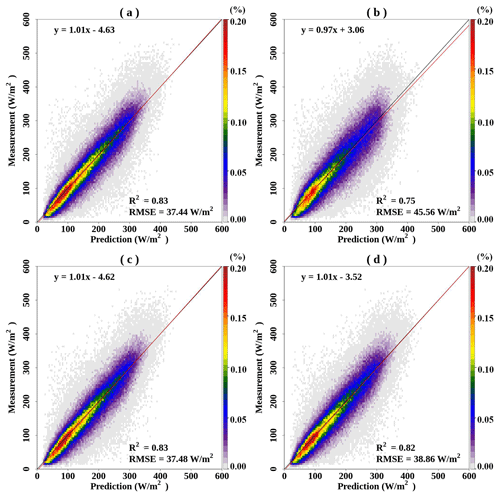
Figure 2Density scatter plots and linear regressions between measurements and predictions of UV radiation at the daily level based on a random forest model during 2005–2020: overall CV (a), spatial CV (b), temporal CV (c), and by-year temporal CV (d).
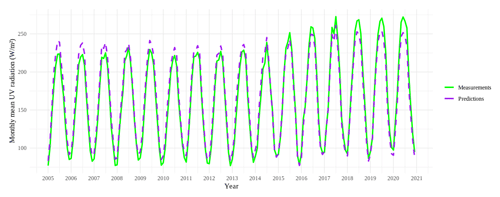
Figure 3Time series plot of monthly mean UV radiation for measurements (green line) and predictions (purple dashes) at monitoring stations during 2005–2020.
Figure A1 illustrates that, with other predictors held constant, the inclusion of OMI EDD as a predictor in the model yielded an overall CV R2 (RMSE) of 0.83 (37.44 W m−2) compared to 0.81 (39.18 W m−2) when OMI EDD was not included.
3.3 Impacts of predictors on UV radiation predictions
Figure A2 shows the importance ranking of all predictors produced by the random forest model itself, which shows that ERA5 UV, OMI EDD, and MAIAC AOD were the most important predictors of UV radiation. Figure 4 shows the SHAP summary plot and feature importance, which were the same as that of the random forest method. The SHAP method also provided the evaluation of the impact directions of predictors on UV radiation predictions. In Fig. 4a, each point represents a sample from the dataset. The color of each point indicates the magnitude of the predictor, with redder values indicating higher values and bluer indicating lower values. For example, ERA5 UV and OMI EDD exerted the most substantial impact and similar impact directions on UV radiation predictions. High values of ERA5 UV and OMI EDD increased the predicted UV radiation predictions, whereas low values decreased UV radiation predictions. Ambient aerosols (MAIAC AOD) and O3 levels showed opposite effects on UV radiation predictions based on the SHAP method. Higher MAIAC AOD values displayed higher negative SHAP values, meaning that higher MAIAC AOD values tended to associate with decreased UV radiation levels. Conversely, high O3 levels corresponded to positive SHAP values, indicating that high O3 levels were associated with high UV radiation predictions.
3.4 Spatiotemporal distributions of UV radiation based on predictions
The spatial distribution of annual average UV radiation based on predictions from 2005 to 2020 is shown in Fig. A3 for each year and in Fig. 5 for the average values from 2005 to 2020, indicating an uneven spatial distribution of UV radiation in China associated with factors such as latitude and elevation (Fig. A4) and meteorological factors. On the one hand, UV radiation was stronger in the southern region at lower latitudes than in the northern region at higher latitudes. For example, in subregion G in Fig. 5, located at the southernmost latitude in mainland China (∼18° N), the UV radiation value was 205.86 W m−2, 1.46 times that in subregion A, situated at the northernmost latitude in China (∼50° N). On the other hand, UV radiation was higher in western regions with higher elevation than in regions with lower elevation; for example, subregion C, with an average elevation of 4730 m, had the highest UV radiation level of 228.36 W m−2; 1.50 times that of subregion E, with an average elevation of 5 m. However, because of the influence of climatic factors, the relationship between UV radiation and latitude as well as elevation may vary in some regions. For example, subregions D and F have similar elevations and latitudes, but UV radiation at subregion F was 152.14 W m−2, 14.29 % higher than that at D. Figure A5 shows the population density, indicating that although subregion C had the highest UV radiation in China, its population is sparse, while the southeastern coastal areas of China, with dense populations, had relatively strong UV radiation and thus a relatively higher population exposure risk.
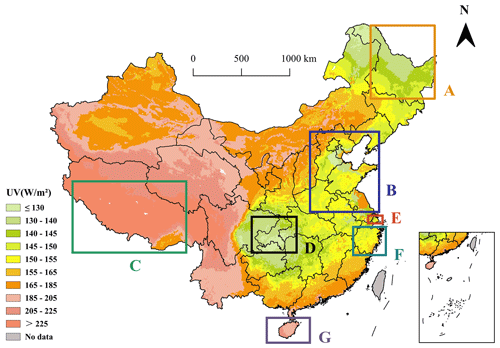
Figure 5Spatial distribution of averaged annual-mean UV radiation during 2005–2020. Heilongjiang province (A), North China Plain (B), Tibet Autonomous Region (C), Chongqing (D), Shanghai (E), Zhejiang province (F), and Hainan province (G).
The inter-annual and intra-annual trends in UV radiation are shown in Fig. 6. For long-term temporal trends, UV radiation experienced slight fluctuations from 2005 to 2014 but remained relatively stable and then increased from 2015. Figure 6a depicts the trends in the changes in UV radiation, O3, and PM2.5 across mainland China from 2013 to 2020, showing that PM2.5 demonstrated a prominent downward trend, whereas both UV radiation and O3 exhibited noticeable upward trends during this period. In comparison to 2013, UV radiation increased by 4.20 % nationwide in 2020, rising from 176.68 to 184.10 W m−2, O3 increased by 22.70 %, while PM2.5 decreased by 48.51 %. Additionally, Fig. A3 shows that the North China Plain (subregion B in Fig. 5) increased the most significantly, with UV radiation increasing by 7.13 % from 2013 to 2020, which was 1.70 times the national growth rate. Regarding intra-annual variation, UV radiation exhibited a clear seasonal trend, with significantly higher levels during summer than during winter. It was highest in July, with an average value of 253.02 W m−2 in 2005–2020, and then gradually decreased, reaching its lowest value in December, with an average of 89.81 W m−2. Additionally, Fig. 6c–f illustrate the varying spatial trends of UV radiation across different seasons. In spring, the intensity of UV radiation in the northern regions surpassed that in most of the southern areas. During summer, the UV radiation across mainland China consistently exceeds 162 W m−2. The spatial distribution of the UV radiation intensity was primarily affected by elevation and latitude in autumn. In winter, except for in some areas in western China, the UV radiation levels remained below 140 W m−2.
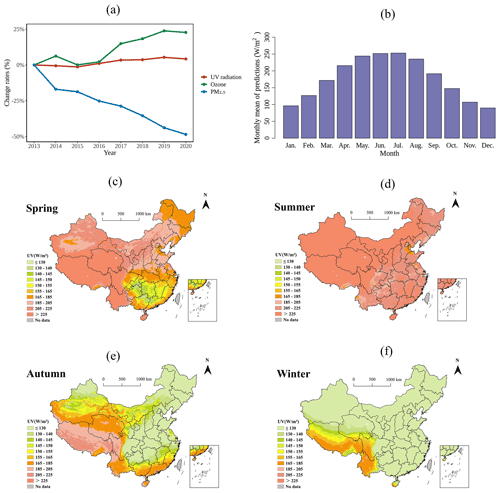
Figure 6Inter-annual and intra-annual variation in UV radiation based on predictions in mainland China. Annual change rates of UV radiation, O3, and PM2.5 in mainland China from 2013 to 2020 (a); averaged monthly mean UV radiation in mainland China in 2005–2020 (b); and average seasonal mean UV radiation in mainland China in 2005–2020 in spring (c), summer (d), autumn (e), and winter (f).
This study developed a random forest model using a variety of predictors to predict daily UV radiation in mainland China with relatively high accuracy, resolution, and spatiotemporal coverage. Temporal and spatial characteristics were identified based on the predictions generated from the model. A gradual increase in UV radiation in recent years was observed, with an uneven spatial distribution.
This study predicted UV radiation based on a machine learning algorithm at the daily level and with a 10 km spatial resolution with nearly full coverage in China using multiple predictors, including satellite and simulated UV radiation data. The R2 (RMSE) between measured and predicted UV radiation was 0.97 (15.64 W m−2) for model development and 0.83 (37.44 W m−2) for overall 10-fold CV at the daily level. Compared to other environmental factors affecting population health, such as air pollution, few studies have developed models for UV radiation, and most have been conducted in the United States and Europe using statistical models such as regression analysis and area-to-point residual kriging (Feister et al., 2008; Junk et al., 2007; Pei and He, 2019; VoPham et al., 2016). In recent years, several studies have employed machine learning algorithms such as deep neural networks, support vector machine, and tree methods to predict UV radiation (Wu et al., 2022; Zhao and He, 2022). In previous studies, R2 between measured and predicted UV radiation for model development ranged from 0.92 to 0.98 (Liu et al., 2017; Zhao and He, 2022; Qin et al., 2020), which was comparable with our results. In this study, we employed the random forest method to develop the models as it is a widely used machine learning algorithm with several advantages for predicting multiple environmental factors (Araki et al., 2018; Guo et al., 2021; Huang et al., 2018; Liu et al., 2020). First, random forest exhibits high flexibility in processing various types of data and strong tolerance to multicollinearity among predictors (Breiman, 2001; Fox et al., 2017; Strobl et al., 2008; Bamrah et al., 2020). Second, comparing to some other black-box machine learning models, the random forest method is able to provide feature importance rankings and facilitate a deeper understanding of the contribution of all predictors in predictions, which makes the models easier to understand and explain (Hu et al., 2017; Wei et al., 2019). Third, the predicting errors in random forest models are generally lower due to the reduction in variance achieved by aggregating multiple trees (Ameer et al., 2019; Ding and Qie, 2022). Fourth, random forest is user-friendly, with a relatively small number of parameter settings and a relatively fast processing speed (Ameer et al., 2019; Hu et al., 2017). Due to the above advantages, many previous studies found that the random forest method could achieve higher or at least comparable predicting accuracy over other machine learning models in predicting environmental factors (Liang et al., 2020; Ochando et al., 2015; Contreras and Ferri, 2016; Ameer et al., 2019). In this study, we also compared results from the random forest model and eXtreme Gradient Boosting (XGBoost) model, which is another machine learning model based on decision trees with relatively high predicting accuracy (Zamani Joharestani et al., 2019; Nasabpour Molaei et al., 2023; Dai et al., 2023; Wu et al., 2022). The results indicated that the predicting accuracy from XGBoost method was comparable but slightly lower than those of the random forest method with lower R2 (0.81 for XGBoost vs. 0.83 for random forest) and higher RMSE (39.25 W m−2 for XGBoost vs. 37.44 W m−2 for random forest). Several studies have developed models to predict UV radiation in China; however, the role of satellite UV radiation measurements in model performance has not been investigated. UV radiation data from satellites have proven to be an effective variable for evaluating exposure levels and identifying hotspots of skin cancer risk in other countries (Zhou et al., 2019; Kennedy et al., 2021). Satellite-sourced UV radiation data, such as OMI EDD, offer a form of direct measurements of UV radiation from satellites, providing “real values” to constrain UV radiation predictions during spatial extrapolation (Gholamnia et al., 2021). Including the OMI EDD in the UV radiation model improved the prediction accuracy by approximately 2 % compared to the model without it in this study. Additionally, this study filled in the missing values of OMI EDD data to make the spatiotemporal coverage of UV radiation predictions close to 100 %, which was higher than previous studies that predicted UV radiation at 724 conventional meteorological stations in China or those that did not address the missing values in UV radiation predictions caused by incomplete predictor variables, such as AOD data from remote sensing (Wu et al., 2022; Liu et al., 2017). Gridded UV radiation predictions with nearly full spatiotemporal coverage can provide more comprehensive and flexible support for exposure assessment in health studies on exposure windows and geographic locations.
The results indicated that UV radiation is unevenly distributed throughout China, with high-exposure areas primarily located in the southwest and health-risk hotspots primarily located in the eastern region. The spatial distribution of UV radiation is closely correlated with elevation, latitude, and climatic factors. Higher elevations result in stronger UV radiation, primarily because of the thinner atmosphere, meaning that less UV radiation is absorbed or scattered by the atmosphere (Blumthaler et al., 1997). The UV radiation intensity also increases with decreasing latitude, primarily because regions at low latitudes have a smaller SZA (Holzle and Honigsmann, 2005). The spatial distribution of UV radiation in autumn effectively reflects its correlation with elevation and latitude. Meteorological factors affect UV radiation intensity. For example, cloud cover can absorb and scatter UV radiation (Dieste-Velasco et al., 2023). The higher cloud cover and humidity in subregion D resulted in higher UV radiation in F than in D despite their similar elevations and latitudes (Fig. 5). In spring, due to factors such as air currents, the southern regions are subjected to increased precipitation, which results in elevated cloud cover and humidity (Yao et al., 2017). Consequently, this phenomenon may have resulted in lower UV radiation intensity in the southern regions than in the relatively arid northern regions. In addition to natural factors, population distribution should be considered when identifying health-risk hotspots. Although UV radiation levels were medium–high in the southeastern coastal regions, the population health effects due to UV radiation should not be ignored because of the high population density there. The threshold for the health effects of UV radiation on the population is still unclear, and there are no atmospheric UV radiation standards so far, which requires support from further epidemiological studies. The UV radiation predictions in this study covered the entire geographical area of mainland China, providing exposure data to support health studies in different regions and further identify the health-risk hotspots of UV radiation exposure in China.
The UV radiation levels exhibited both seasonal and long-term temporal trends. The seasonal pattern showed the strongest UV radiation in summer and the lowest in winter. This observed pattern may be linked to variations in daylight hours and alterations in the SZA throughout the year (Liu et al., 2017). Specifically, our findings demonstrated an increasing trend in UV radiation since 2015 accompanied by a decrease in PM2.5 and increase in O3, suggesting a potential correlation between UV radiation levels and air pollution. The decrease in PM2.5 may contribute to the increase in UV radiation as PM2.5 can absorb and reflect UV radiation (Madronich et al., 2023; Gao et al., 2013). UV radiation plays a crucial role in the production of surface O3 because ground-level O3 primarily originates from photochemical reactions (Guicherit and Roemer, 2000). Additionally, the results of the SHAP analysis were consistent with the long-term trend analysis, which indicated that ambient aerosols levels were negatively associated with UV radiation predictions, while O3 concentrations positively related to UV radiation levels. The Chinese government launched and implemented a series of nationwide policies to decrease air pollution levels, including the Action Plan of Air Pollution Prevention and Control in 2013 and Three-Year (2018–2020) Action Plan for Cleaner Air in 2017. Owing to these policies, the concentrations of several air pollutants, especially PM2.5, have decreased significantly in China since 2013. Therefore, along with a decrease in PM2.5, there is a need to enhance public awareness of UV radiation protection.
The relatively small number of UV radiation monitoring stations employed for model development across the national landscape may have influenced the extrapolation performance of the model. The UV monitoring stations were distributed in different geographic locations with multiple land-cover types, which helped validate the model performance in spatial extrapolation. However, a spatial CV was conducted, which only slightly decreased compared to the overall CV, showing a relatively higher accuracy of spatial extrapolation.
The UV radiation gridded dataset across mainland China in 2005–2020 is currently freely available at https://doi.org/10.5281/zenodo.10884591 (Jiang et al., 2024).
This study established a machine learning model for predicting daily UV radiation levels at a 10 km×10 km spatial resolution across mainland China for a period of 16 years. The model with satellite-sourced UV radiation measurements had a higher prediction accuracy than the one without such a predictor. Based on high-resolution and coverage predictions, a gradual increase in UV radiation in recent years and an uneven spatial distribution were observed. This study provides a modeling method and exposure data for UV radiation to support exposure assessment for future epidemiological studies and the identification of exposure risk and health-risk hotspots of UV radiation in the Chinese population.
Table A1Statistical descriptions of UV radiation measurements from ground monitoring stations in CERN in China from 2005 to 2020.
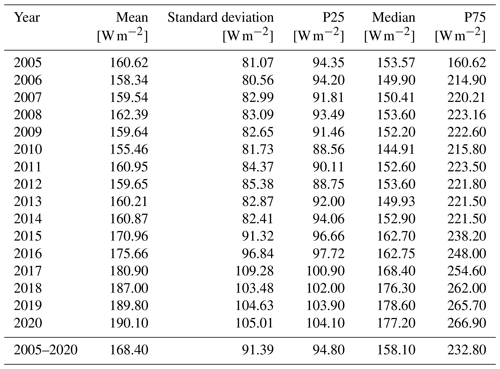
Table A2Missing rate of erythemal daily dose (EDD) retrieved from the Ozone Monitoring Instrument (OMI) before and after gap-filling and the results of 10-fold cross-validation of the 3 d moving average method from 2005 to 2020 in China.
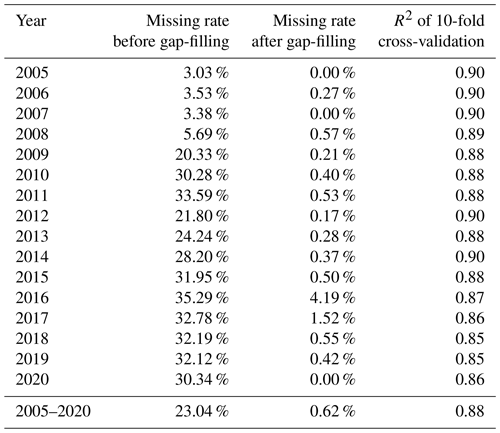
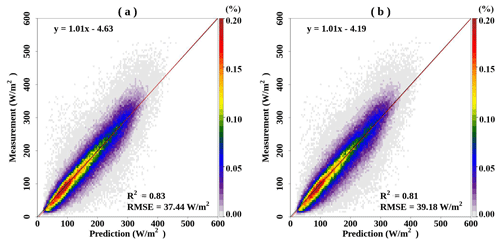
Figure A1Density scatter plots and linear regressions between measurements and predictions of UV radiation at the daily level based on a random forest model during 2005–2020 with erythemally daily dose retrieved from the Ozone Monitoring Instrument (a) and without erythemally daily dose retrieved from the Ozone Monitoring Instrument (b).
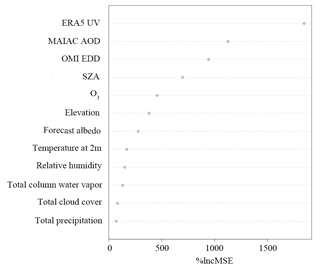
Figure A2Ranking of importance for predictor variables in UV radiation prediction model. Downward UV radiation at the surface from the fifth-generation European Center for Medium-Range Weather Forecasts Reanalysis (ERA5 UV), aerosol optical depth data from the Multi-Angle Implementation of Atmospheric Correction (MAIAC AOD), erythemally daily dose retrieved from the Ozone Monitoring Instrument (OMI EDD), and solar zenith angle (SZA).
YJ: conceptualization, data curation, methodology, software, and writing (original draft preparation and review and editing). SS: data curation, software, and validation. XL: data curation and software. CX: data curation and software. HK: funding acquisition and writing (review and editing). BH: resources, funding acquisition, and writing (review and editing). XM: conceptualization, resources, funding acquisition, supervision, and writing (review and editing).
The contact author has declared that none of the authors has any competing interests.
Publisher's note: Copernicus Publications remains neutral with regard to jurisdictional claims made in the text, published maps, institutional affiliations, or any other geographical representation in this paper. While Copernicus Publications makes every effort to include appropriate place names, the final responsibility lies with the authors. Regarding the maps used in this paper, please note that Figs. 1, 5, 6, A3–A5, and the key figure contain disputed territories.
This research has been supported by the National Key Research and Development Program of China (grant nos. 2023YFC3708304 and 2022YFC3700705) and the National Natural Science Foundation of China (grant no. 82030103).
This paper was edited by Yuqiang Zhang and reviewed by two anonymous referees.
Ameer, S., Shah, M. A., Khan, A., Song, H., Maple, C., Islam, S. U., and Asghar, M. N.: Comparative Analysis of Machine Learning Techniques for Predicting Air Quality in Smart Cities, IEEE Access, 7, 128325–128338, https://doi.org/10.1109/access.2019.2925082, 2019.
Araki, S., Shima, M., and Yamamoto, K.: Spatiotemporal land use random forest model for estimating metropolitan NO2 exposure in Japan, Sci. Total Environ., 634, 1269–1277, https://doi.org/10.1016/j.scitotenv.2018.03.324, 2018.
Bamrah, S. K., Saiharshith, K., and Gayathri, K.: Application of random forests for air quality estimation in india by adopting terrain features, 2020 4th International Conference on Computer, Communication and Signal Processing (ICCCSP), Chennai, India, 28–29 September 2020, 1–6, https://doi.org/10.1109/ICCCSP49186.2020.9315252, 2020.
Bi, J., Wildani, A., Chang, H. H., and Liu, Y.: Incorporating Low-Cost Sensor Measurements into High-Resolution PM2.5 Modeling at a Large Spatial Scale, Environ. Sci. Technol., 54, 2152–2162, https://doi.org/10.1021/acs.est.9b06046, 2020.
Blumthaler, M., Ambach, W., and Ellinger, R.: Increase in solar UV radiation with altitude, J. Photoch. Photobio. B, 39, 130–134, https://doi.org/10.1016/s1011-1344(96)00018-8, 1997.
Boscoe, F. P. and Schymura, M. J.: Solar ultraviolet-B exposure and cancer incidence and mortality in the United States, 1993–2002, BMC Cancer, 6, 264, https://doi.org/10.1186/1471-2407-6-264, 2006.
Breiman, L.: Random Forests, Mach. Learn., 45, 5–32, https://doi.org/10.1023/A:1010933404324, 2001.
Brenner, M. and Hearing, V. J.: The protective role of melanin against UV damage in human skin, Photochem. Photobiol., 84, 539–549, https://doi.org/10.1111/j.1751-1097.2007.00226.x, 2008.
Chen, G., Knibbs, L. D., Zhang, W., Li, S., Cao, W., Guo, J., Ren, H., Wang, B., Wang, H., Williams, G., Hamm, N. A. S., and Guo, Y.: Estimating spatiotemporal distribution of PM1 concentrations in China with satellite remote sensing, meteorology, and land use information, Environ. Pollut., 233, 1086–1094, https://doi.org/10.1016/j.envpol.2017.10.011, 2018.
Chen, Y., Liang, S., Ma, H., Li, B., He, T., and Wang, Q.: An all-sky 1 km daily land surface air temperature product over mainland China for 2003–2019 from MODIS and ancillary data, Earth Syst. Sci. Data, 13, 4241–4261, https://doi.org/10.5194/essd-13-4241-2021, 2021.
Contreras, L. and Ferri, C.: Wind-sensitive interpolation of urban air pollution forecasts, Procedia Comput. Sci., 80, 313–323, https://doi.org/10.1016/j.procs.2016.05.343, 2016.
Corrêa, M. d. P.: UVBoost: An erythemal weighted ultraviolet radiation estimator based on a machine learning gradient boosting algorithm, J. Quant. Spectrosc. Ra., 298, 108490, https://doi.org/10.1016/j.jqsrt.2023.108490, 2023.
Dai, H., Huang, G., Wang, J., and Zeng, H.: VAR-tree model based spatio-temporal characterization and prediction of O3 concentration in China, Ecotox. Environ. Safe., 257, 114960, https://doi.org/10.1016/j.ecoenv.2023.114960, 2023.
Deng, Y., Yang, D., Yu, J. M., Xu, J. X., Hua, H., Chen, R. T., Wang, N., Ou, F. R., Liu, R. X., Wu, B., and Liu, Y.: The Association of Socioeconomic Status with the Burden of Cataract-related Blindness and the Effect of Ultraviolet Radiation Exposure: An Ecological Study, Biomed. Environ. Sci., 34, 101–109, https://doi.org/10.3967/bes2021.015, 2021.
Dieste-Velasco, M. I., García-Rodríguez, S., García-Rodríguez, A., Díez-Mediavilla, M., and Alonso-Tristán, C.: Modeling Horizontal Ultraviolet Irradiance for All Sky Conditions by Using Artificial Neural Networks and Regression Models, Appl. Sci.-Basel, 13, 1473, https://doi.org/10.3390/app13031473, 2023.
Ding, W. and Qie, X.: Prediction of Air Pollutant Concentrations via RANDOM Forest Regressor Coupled with Uncertainty Analysis – A Case Study in Ningxia, Atmosphere-Basel, 13, 960, https://doi.org/10.3390/atmos13060960, 2022.
Feister, U., Junk, J., Woldt, M., Bais, A., Helbig, A., Janouch, M., Josefsson, W., Kazantzidis, A., Lindfors, A., den Outer, P. N., and Slaper, H.: Long-term solar UV radiation reconstructed by ANN modelling with emphasis on spatial characteristics of input data, Atmos. Chem. Phys., 8, 3107–3118, https://doi.org/10.5194/acp-8-3107-2008, 2008.
Fox, E. W., Hill, R. A., Leibowitz, S. G., Olsen, A. R., Thornbrugh, D. J., and Weber, M. H.: Assessing the accuracy and stability of variable selection methods for random forest modeling in ecology, Environ. Monit. Assess., 189, 316, https://doi.org/10.1007/s10661-017-6025-0, 2017.
Gao, Z., Gao, W., and Chang, N.-B.: Spatial Statistical Analyses of Global Trends of Ultraviolet B Fluxes in the Continental United States, GISci. Remote Sens., 49, 735–754, https://doi.org/10.2747/1548-1603.49.5.735, 2013.
Geyh, A. S., Xue, J., Ozkaynak, H., and Spengler, J. D.: The Harvard Southern California Chronic Ozone Exposure Study: Assessing Ozone Exposure of Grade-School-Age Children in Two Southern California Communities, Environ. Health Persp., 108, 265–270, https://doi.org/10.1289/ehp.00108265, 2000.
Gholamnia, R., Abtahi, M., Dobaradaran, S., Koolivand, A., Jorfi, S., Khaloo, S. S., Bagheri, A., Vaziri, M. H., Atabaki, Y., Alhouei, F., and Saeedi, R.: Spatiotemporal analysis of solar ultraviolet radiation based on Ozone Monitoring Instrument dataset in Iran, 2005–2019, Environ. Pollut., 287, 117643, https://doi.org/10.1016/j.envpol.2021.117643, 2021.
González-Rodríguez, L., Rodríguez-López, L., Jiménez, J., Rosas, J., García, W., Duran-Llacer, I., de Oliveira, A. P., and Barja, B.: Spatio-temporal estimations of ultraviolet erythemal radiation in Central Chile, Air Qual. Atmos. Hlth., 15, 837–852, https://doi.org/10.1007/s11869-022-01195-y, 2022.
Grandahl, K., Eriksen, P., Ibler, K. S., Bonde, J. P., and Mortensen, O. S.: Measurements of Solar Ultraviolet Radiation Exposure at Work and at Leisure in Danish Workers, Photochem. Photobiol., 94, 807–814, https://doi.org/10.1111/php.12920, 2018.
Griffin, G. K., Booth, C. A. G., Togami, K., Chung, S. S., Ssozi, D., Verga, J. A., Bouyssou, J. M., Lee, Y. S., Shanmugam, V., Hornick, J. L., LeBoeuf, N. R., Morgan, E. A., Bernstein, B. E., Hovestadt, V., van Galen, P., and Lane, A. A.: Ultraviolet radiation shapes dendritic cell leukaemia transformation in the skin, Nature, 618, 834–841, https://doi.org/10.1038/s41586-023-06156-8, 2023.
Guicherit, R. and Roemer, M.: Tropospheric ozone trends, Chemosphere-Global Change Science, 2, 167–183, https://doi.org/10.1016/S1465-9972(00)00008-8, 2000.
Guo, B., Zhang, D., Pei, L., Su, Y., Wang, X., Bian, Y., Zhang, D., Yao, W., Zhou, Z., and Guo, L.: Estimating PM2.5 concentrations via random forest method using satellite, auxiliary, and ground-level station dataset at multiple temporal scales across China in 2017, Sci. Total Environ., 778, 146288, https://doi.org/10.1016/j.scitotenv.2021.146288, 2021.
Habte, A., Sengupta, M., Gueymard, C. A., Narasappa, R., Rosseler, O., and Burns, D. M.: Estimating Ultraviolet Radiation From Global Horizontal Irradiance, IEEE J. Photovolt., 9, 139–146, https://doi.org/10.1109/jphotov.2018.2871780, 2019.
He, Q., Gao, K., Zhang, L., Song, Y., and Zhang, M.: Satellite-derived 1 km estimates and long-term trends of PM2.5 concentrations in China from 2000 to 2018, Environ. Int., 156, 106726, https://doi.org/10.1016/j.envint.2021.106726, 2021.
He, Q., Ye, T., Chen, X., Dong, H., Wang, W., Liang, Y., and Li, Y.: Full-coverage mapping high-resolution atmospheric CO2 concentrations in China from 2015 to 2020: Spatiotemporal variations and coupled trends with particulate pollution, J. Clean. Prod., 428, 139290, https://doi.org/10.1016/j.jclepro.2023.139290, 2023a.
He, Q., Ye, T., Zhang, M., and Yuan, Y.: Enhancing the reliability of hindcast modeling for air pollution using history-informed machine learning and satellite remote sensing in China, Atmos. Environ., 312, 119994, https://doi.org/10.1016/j.atmosenv.2023.119994, 2023b.
Holzle, E. and Honigsmann, H.: UV-radiation-Sources, Wavelength, Environment, J. Dtsch. Dermatol. Ges., 3, S3–S10, https://doi.org/10.1111/j.1610-0387.2005.04392.x, 2005.
Hsu, C. Y., Wu, J. Y., Chen, Y. C., Chen, N. T., Chen, M. J., Pan, W. C., Lung, S. C., Guo, Y. L., and Wu, C. D.: Asian Culturally Specific Predictors in a Large-Scale Land Use Regression Model to Predict Spatial-Temporal Variability of Ozone Concentration, Int J Env. Res. Pub. He., 16, 1300, https://doi.org/10.3390/ijerph16071300, 2019.
Hu, B., Wang, Y., and Liu, G.: Variation characteristics of ultraviolet radiation derived from measurement and reconstruction in Beijing, China, Tellus B, 62, 100–108, https://doi.org/10.1111/j.1600-0889.2010.00452.x, 2010.
Hu, X., Belle, J. H., Meng, X., Wildani, A., Waller, L. A., Strickland, M. J., and Liu, Y.: Estimating PM2.5 Concentrations in the Conterminous United States Using the Random Forest Approach, Environ. Sci. Technol., 51, 6936–6944, https://doi.org/10.1021/acs.est.7b01210, 2017.
Huang, K., Xiao, Q., Meng, X., Geng, G., Wang, Y., Lyapustin, A., Gu, D., and Liu, Y.: Predicting monthly high-resolution PM2.5 concentrations with random forest model in the North China Plain, Environ. Pollut., 242, 675–683, https://doi.org/10.1016/j.envpol.2018.07.016, 2018.
Jiang, Y., Shi, S., Li, X., Xu, C., Kan, H., Hu, B., and Meng, X.: A database of 10 km Ultraviolet Radiation Product over mainland China: 2005–2020, Zenodo [data set], https://doi.org/10.5281/zenodo.10884591,2024.
Junk, J., Feister, U., and Helbig, A.: Reconstruction of daily solar UV irradiation from 1893 to 2002 in Potsdam, Germany, Int. J. Biometeorol., 51, 505–512, https://doi.org/10.1007/s00484-007-0089-4, 2007.
Kennedy, C., Liu, Y., Meng, X., Strosnider, H., Waller, L. A., and Zhou, Y.: Developing indices to identify hotspots of skin cancer vulnerability among the Non-Hispanic White population in the United States, Ann. Epidemiol., 59, 64–71, https://doi.org/10.1016/j.annepidem.2021.04.004, 2021.
Lagreze, W. A., Joachimsen, L., and Schaeffel, F.: [Current recommendations for deceleration of myopia progression], Ophthalmologe, 114, 24–29, https://doi.org/10.1007/s00347-016-0346-1, 2017.
Liang, Y.-C., Maimury, Y., Chen, A. H.-L., and Juarez, J. R. C.: Machine Learning-Based Prediction of Air Quality, Appl. Sci.-Basel, 10, 9151, https://doi.org/10.3390/app10249151, 2020.
Lin, S. W., Wheeler, D. C., Park, Y., Cahoon, E. K., Hollenbeck, A. R., Freedman, D. M., and Abnet, C. C.: Prospective study of ultraviolet radiation exposure and risk of cancer in the United States, Int. J. Cancer, 131, E1015–E1023, https://doi.org/10.1002/ijc.27619, 2012.
Liu, H., Hu, B., Zhang, L., Zhao, X. J., Shang, K. Z., Wang, Y. S., and Wang, J.: Ultraviolet radiation over China: Spatial distribution and trends, Renew. Sust. Energ. Rev., 76, 1371–1383, https://doi.org/10.1016/j.rser.2017.03.102, 2017.
Liu, H., Liu, J., Liu, Y., Ouyang, B., Xiang, S., Yi, K., and Tao, S.: Analysis of wintertime O3 variability using a random forest model and high-frequency observations in Zhangjiakou-an area with background pollution level of the North China Plain, Environ. Pollut., 262, 114191, https://doi.org/10.1016/j.envpol.2020.114191, 2020.
Liu, S., Geng, G., Xiao, Q., Zheng, Y., Liu, X., Cheng, J., and Zhang, Q.: Tracking Daily Concentrations of PM2.5 Chemical Composition in China since 2000, Environ. Sci. Technol., 56, 16517–16527, https://doi.org/10.1021/acs.est.2c06510, 2022.
Lu, T., Marshall, J. D., Zhang, W., Hystad, P., Kim, S. Y., Bechle, M. J., Demuzere, M., and Hankey, S.: National Empirical Models of Air Pollution Using Microscale Measures of the Urban Environment, Environ. Sci. Technol., 55, 15519–15530, https://doi.org/10.1021/acs.est.1c04047, 2021.
Lu, Y., Giuliano, G., and Habre, R.: Estimating hourly PM2.5 concentrations at the neighborhood scale using a low-cost air sensor network: A Los Angeles case study, Environ. Res., 195, 110653, https://doi.org/10.1016/j.envres.2020.110653, 2021.
Lundberg, S. M. and Lee, S.-I.: A unified approach to interpreting model predictions, in: Proceedings of the 31st International Conference on Neural Information Processing Systems, NIPS'17, 4–9 December 2017, Long Beach, California, USA, Adv. Neur. In., 30, 4768–4777, https://doi.org/10.5555/3295222.3295230, 2017.
Lundberg, S. M., Erion, G., Chen, H., DeGrave, A., Prutkin, J. M., Nair, B., Katz, R., Himmelfarb, J., Bansal, N., and Lee, S. I.: From Local Explanations to Global Understanding with Explainable AI for Trees, Nat. Mach. Intell., 2, 56–67, https://doi.org/10.1038/s42256-019-0138-9, 2020.
Madronich, S., Sulzberger, B., Longstreth, J. D., Schikowski, T., Andersen, M. P. S., Solomon, K. R., and Wilson, S. R.: Changes in tropospheric air quality related to the protection of stratospheric ozone in a changing climate, Photochem. Photobio. S., 22, 1129–1176, https://doi.org/10.1007/s43630-023-00369-6, 2023.
Marson, J. W., Litchman, G. H., and Rigel, D. S.: The magnitude of increased United States melanoma incidence attributable to ground-level ultraviolet radiation intensity trends, J. Am. Acad. Dermatol., 84, 1734–1735, https://doi.org/10.1016/j.jaad.2020.08.100, 2021.
McPeters, R. D., Frith, S., and Labow, G. J.: OMI total column ozone: extending the long-term data record, Atmos. Meas. Tech., 8, 4845–4850, https://doi.org/10.5194/amt-8-4845-2015, 2015.
Meng, X., Liu, C., Zhang, L., Wang, W., Stowell, J., Kan, H., and Liu, Y.: Estimating PM2.5 concentrations in Northeastern China with full spatiotemporal coverage, 2005–2016, Remote Sens. Environ., 253, 112203, https://doi.org/10.1016/j.rse.2020.112203, 2021.
Meng, X., Wang, W., Shi, S., Zhu, S., Wang, P., Chen, R., Xiao, Q., Xue, T., Geng, G., Zhang, Q., Kan, H., and Zhang, H.: Evaluating the spatiotemporal ozone characteristics with high-resolution predictions in mainland China, 2013–2019, Environ. Pollut., 299, 118865, https://doi.org/10.1016/j.envpol.2022.118865, 2022.
Mohr, S. B., Garland, C. F., Gorham, E. D., Grant, W. B., and Garland, F. C.: Relationship between low ultraviolet B irradiance and higher breast cancer risk in 107 countries, Breast J., 14, 255–260, https://doi.org/10.1111/j.1524-4741.2008.00571.x, 2008.
Narayanan, D. L., Saladi, R. N., and Fox, J. L.: Ultraviolet radiation and skin cancer, Int. J. Dermatol., 49, 978–986, https://doi.org/10.1111/j.1365-4632.2010.04474.x, 2010.
Nasabpour Molaei, S., Salajegheh, A., Khosravi, H., Nasiri, A., and Ranjbar Saadat Abadi, A.: Prediction of hourly PM10 concentration through a hybrid deep learning-based method, Earth Sci. Inform., 17, 37–49, https://doi.org/10.1007/s12145-023-01146-w, 2023.
Ochando, L. C., Julián, C. I., and Ferri, C.: Airvlc: An application for real-time forecasting urban air pollution, Proceedings of the 2nd International Workshop on Mining Urban, 11 July 2015, Lille, France, 1392, 72–79, https://doi.org/10.5555/3045776.3045786, 2015.
Park, S., Im, J., Kim, J., and Kim, S. M.: Geostationary satellite-derived ground-level particulate matter concentrations using real-time machine learning in Northeast Asia, Environ. Pollut., 306, 119425, https://doi.org/10.1016/j.envpol.2022.119425, 2022.
Pei, C. and He, T.: UV Radiation Estimation in the United States using Modis Data, in: IGARSS 2019 – 2019 IEEE International Geoscience and Remote Sensing Symposium, 28 July 2019–2 August, Yokohama, Japan, 1880–1883, https://doi.org/10.1109/IGARSS.2019.8900659, 2019.
Qin, W., Wang, L., Wei, J., Hu, B., and Liang, X.: A novel efficient broadband model to derive daily surface solar Ultraviolet radiation (0.280–0.400 µm), Sci. Total Environ., 735, 139513, https://doi.org/10.1016/j.scitotenv.2020.139513, 2020.
Santos, J. B., Villán, D. M., and Castrillo, A. d. M.: Analysis and cloudiness influence on UV total irradiation, Int. J. Climatol., 31, 451–460, https://doi.org/10.1002/joc.2072, 2011.
Shi, S., Wang, W., Li, X., Hang, Y., Lei, J., Kan, H., and Meng, X.: Optimizing modeling windows to better capture the long-term variation of PM2.5 concentrations in China during 2005–2019, Sci. Total Environ., 854, 158624, https://doi.org/10.1016/j.scitotenv.2022.158624, 2023a.
Shi, S., Wang, W., Li, X., Xu, C., Lei, J., Jiang, Y., Zhang, L., He, C., Xue, T., Chen, R., Kan, H., and Meng, X.: Evolution in disparity of PM2.5 pollution in China, Eco-Environment & Health, 2, 257–263, https://doi.org/10.1016/j.eehl.2023.08.007, 2023b.
Strobl, C., Boulesteix, A. L., Kneib, T., Augustin, T., and Zeileis, A.: Conditional variable importance for random forests, BMC Bioinformatics, 9, 307, https://doi.org/10.1186/1471-2105-9-307, 2008.
Strumbelj, E. and Kononenko, I.: An Efficient Explanation of Individual Classifications using Game Theory, J. Mach. Learn. Res., 11, 1–18, https://doi.org/10.1515/9781400829156-012, 2010.
Stump, T. K., Fastner, S., Jo, Y., Chipman, J., Haaland, B., Nagelhout, E. S., Wankier, A. P., Lensink, R., Zhu, A., Parsons, B., Grossman, D., and Wu, Y. P.: Objectively-Assessed Ultraviolet Radiation Exposure and Sunburn Occurrence, Int J Env. Res. Pub. He., 20, 5234, https://doi.org/10.3390/ijerph20075234, 2023.
Swaminathan, A., Harrison, S. L., Ketheesan, N., van den Boogaard, C. H. A., Dear, K., Allen, M., Hart, P. H., Cook, M., and Lucas, R. M.: Exposure to Solar UVR Suppresses Cell-Mediated Immunization Responses in Humans: The Australian Ultraviolet Radiation and Immunity Study, J. Invest. Dermatol., 139, 1545–1553, https://doi.org/10.1016/j.jid.2018.12.025, 2019.
Thayer, Z. M.: The vitamin D hypothesis revisited: race-based disparities in birth outcomes in the United States and ultraviolet light availability, Am. J. Epidemiol., 179, 947–955, https://doi.org/10.1093/aje/kwu023, 2014.
Tian, X., Zhang, B., Jia, Y., Wang, C., and Li, Q.: Retinal changes following rapid ascent to a high-altitude environment, Eye, 32, 370–374, https://doi.org/10.1038/eye.2017.195, 2018.
Vienneau, D., De Hoogh, K., Hauri, D., Vicedo-Cabrera, A. M., Schindler, C., Huss, A., Roosli, M., and SNC Study Group: Effects of Radon and UV Exposure on Skin Cancer Mortality in Switzerland, Environ. Health Persp., 125, 067009, https://doi.org/10.1289/EHP825, 2017.
VoPham, T., Hart, J. E., Bertrand, K. A., Sun, Z., Tamimi, R. M., and Laden, F.: Spatiotemporal exposure modeling of ambient erythemal ultraviolet radiation, Environ. Health, 15, 111, https://doi.org/10.1186/s12940-016-0197-x, 2016.
VoPham, T., Bertrand, K. A., Yuan, J. M., Tamimi, R. M., Hart, J. E., and Laden, F.: Ambient ultraviolet radiation exposure and hepatocellular carcinoma incidence in the United States, Environ. Health, 16, 89, https://doi.org/10.1186/s12940-017-0299-0, 2017.
Walls, A. C., Han, J., Li, T., and Qureshi, A. A.: Host risk factors, ultraviolet index of residence, and incident malignant melanoma in situ among US women and men, Am. J. Epidemiol., 177, 997–1005, https://doi.org/10.1093/aje/kws335, 2013.
Wang, Y., Hu, X., Chang, H. H., Waller, L. A., Belle, J. H., and Liu, Y.: A Bayesian Downscaler Model to Estimate Daily PM2.5 Levels in the Conterminous US, Int. J. Env. Res. Pub. He., 15, 1999, https://doi.org/10.3390/ijerph15091999, 2018.
Wei, J., Huang, W., Li, Z., Xue, W., Peng, Y., Sun, L., and Cribb, M.: Estimating 1-km-resolution PM2.5 concentrations across China using the space-time random forest approach, Remote Sens. Environ., 231, 111221, https://doi.org/10.1016/j.rse.2019.111221, 2019.
Wolffsohn, J. S., Dhallu, S., Aujla, M., Laughton, D., Tempany, K., Powell, D., Gifford, K., Gifford, P., Wan, K., Cho, P., Stahl, U., and Woods, J.: International multi-centre study of potential benefits of ultraviolet radiation protection using contact lenses, Contact Lens Anterio., 45, 101593, https://doi.org/10.1016/j.clae.2022.101593, 2022.
Wongnakae, P., Chitchum, P., Sripramong, R., and Phosri, A.: Application of satellite remote sensing data and random forest approach to estimate ground-level PM2.5 concentration in Northern region of Thailand, Environ. Sci. Pollut. R., 30, 88905–88917, https://doi.org/10.1007/s11356-023-28698-0, 2023.
Wu, J., Wang, Y., Liang, J., and Yao, F.: Exploring common factors influencing PM2.5 and O3 concentrations in the Pearl River Delta: Tradeoffs and synergies, Environ. Pollut., 285, 117138, https://doi.org/10.1016/j.envpol.2021.117138, 2021.
Wu, J., Qin, W., Wang, L., Hu, B., Song, Y., and Zhang, M.: Mapping clear-sky surface solar ultraviolet radiation in China at 1 km spatial resolution using Machine Learning technique and Google Earth Engine, Atmos. Environ., 286, 119219, https://doi.org/10.1016/j.atmosenv.2022.119219, 2022.
Yao, S., Jiang, D., and Fan, G.: Seasonality of Precipitation over China, J. Sciences, 46, 1191–1203, https://doi.org/10.3878/j.issn.1006-9895.1703.16233, 2017 (in Chinese).
Zamani Joharestani, M., Cao, C., Ni, X., Bashir, B., and Talebiesfandarani, S.: PM2.5 Prediction Based on Random Forest, XGBoost, and Deep Learning Using Multisource Remote Sensing Data, Atmosphere-Basel, 10, 373, https://doi.org/10.3390/atmos10070373, 2019.
Zhao, R. and He, T.: Estimation of 1 km Resolution All-Sky Instantaneous Erythemal UV-B with MODIS Data Based on a Deep Learning Method, Remote Sens.-Basel, 14, 384, https://doi.org/10.3390/rs14020384, 2022.
Zhou, Y., Meng, X., Belle, J. H., Zhang, H., Kennedy, C., Al-Hamdan, M. Z., Wang, J., and Liu, Y.: Compilation and spatio-temporal analysis of publicly available total solar and UV irradiance data in the contiguous United States, Environ. Pollut., 253, 130–140, https://doi.org/10.1016/j.envpol.2019.06.074, 2019.
Zhu, Q., Bi, J., Liu, X., Li, S., Wang, W., Zhao, Y., and Liu, Y.: Satellite-Based Long-Term Spatiotemporal Patterns of Surface Ozone Concentrations in China: 2005–2019, Environ. Health Persp., 130, 27004, https://doi.org/10.1289/EHP9406, 2022.





